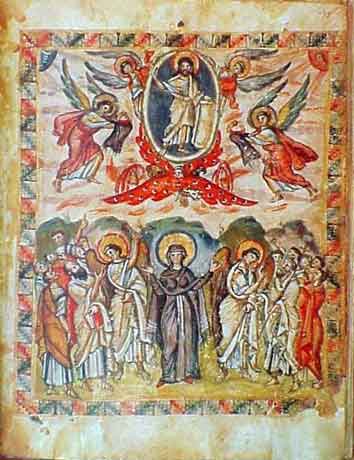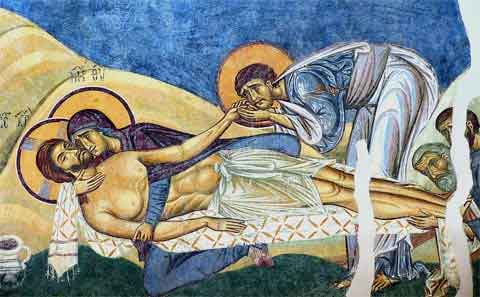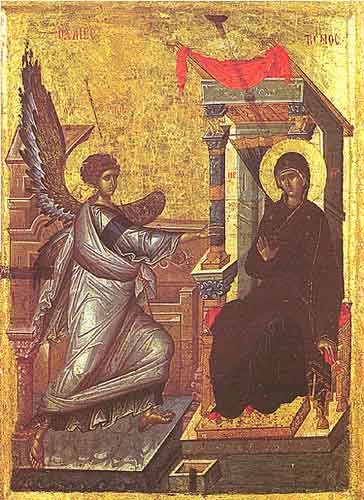.
Byzantine art is the term commonly used to describe the artistic products of the Eastern Roman Empire from about the 5th century until the fall of Constantinople in 1453. (The Roman Empire during this period is conventionally known as the Byzantine Empire.)
The term can also be used for the art of states which were contemporary with the Byzantine Empire and shared a common culture with it, without actually being part of it, such as Bulgaria, Serbia or Russia, and also Venice, which had close ties to the Byzantine Empire despite being in other respects part of western European culture. It can also be used for the art of peoples of the former Byzantine Empire under the rule of the Ottoman Empire after 1453. In some respects the Byzantine artistic tradition has continued in Greece, Russia and other Eastern Orthodox countries to the present day.

Miniatures of the 6th-century Rabula Gospel display a mixture of the Hellenistic and Oriental influences, typical for the Byzantine art.
Introduction
Byzantine art grew from the art of Ancient Greece, and at least before 1453 never lost sight of its classical heritage, but was distinguished from it in a number of ways. The most profound of these was that the humanist ethic of Ancient Greek art was enhanced by the Christian ethic. If the purpose of classical art was the glorification of man, the purpose of Byzantine art was the glorification of God, and particularly of his son, Jesus. But because Jesus was of course human, the Byzantine artistic tradition can be argued to have continued this rich humanist heritage.
In place of the nude, the figures of God the Father, Jesus Christ, the Virgin Mary, and the saints and martyrs of Christian tradition were elevated, and became the dominant - indeed almost exclusive - focus of Byzantine art. One of the most important forms of Byzantine art was, and still is, the icon: an image of Christ, the Virgin (particularly the Virgin and Child), or a saint, used as an object of veneration in Orthodox churches and private homes.
Another consequence of the triumph of Christianity was a decline in the importance of naturalistic representation in art. This is sometimes interpreted as a decline in artistic skills and standards, and it is true that some of the technical expertise of the classical world, particularly in sculpture, was lost in the Byzantine world. Recent scholarly views however have ascertained that the humanist heritage in Byzantine art was never completely lost, and experienced several revivals throughout its history. In fact, Byzantine art can be understood to preserve naturalist tradition at a time when it was completely lost in the West. As the eminent art historian Otto Demus has argued in his book Byzantine Art and the West, it was the safeguarding of the Hellenic heritage by Byzantine art that made possible the Western Renaissance.
Although popular perception may consider that Byzantine art lost interest in the realistic depiction of actual people, closer observation shows this not to be the case. Art historian Hans Belting argued in his book Likeness and Presence that early Byzantine art has long been unfairly judged anachronistically with late modern "aesthetic" lenses, when in fact icons have to be perceived on their own terms - those of "likeness" to the saint using carefully guarded traditions of representation, and the unique "presence" of that saint which is mediated through the icon. This perspective, he says, is made possible through the deeply aesthetic theologies of both John of Damascus and Theodore of Studion, whose perspectives on images anticipated recent developments of contemporary semiotics by over a millennium.
There was a revival in realistic portraiture from the 12th century onwards, a development which some art historians believe influenced the Renaissance in western Europe.
The Byzantines did not see these changes as representing as a decline from the days of Ancient Greece. They saw it as the harnessing of artistic skill to the service of the one true religion, rather than using it for the production of pagan idols or the gratification of personal vanity and sensual pleasure, as the ancients (in their view) had done. While the classical artist strove to depict physical perfection in the human form, the Byzantine artist sought to depict the inner or spiritual nature of his subjects. To this end simplification and stylisation were perfectly acceptable.
In any case, it was only in some areas, principally sculpture, that the Byzantines lost the technical attainments of the ancients. In other areas they developed new techniques and reached new heights. Byzantine gold and silversmithing, enamel-work, jewellery and textiles were the equal of anything done in ancient times. In mosaics and icon-painting they developed major and original art forms of their own. In architecture they achieved masterpieces such as Hagia Sophia, a building of superior scale and magnificence to anything in the ancient world.

Frescoes in Nerezi near Skopje (1164), with their unique blend of high tragedy, gentle humanity, and homespun realism, anticipate the approach of Giotto and other proto-Renaissance Italian artists.
Periods
Artistic forms characteristic of Byzantine art began to develop in the Roman Empire as early as the 4th century, as the classical tradition declined in vitality and eastern influences were more widely felt. The founding of Constantinople in 324 created a great new artistic centre for the eastern half of the Empire, and a specifically Christian one. But other artistic traditions flourished in rival cities such as Alexandria and Antioch, as well as Rome. It was not until all of these cities had fallen - the first two to the Arabs and Rome to the Goths - that Constantinople established its supremacy.
The first great age of Byzantine art coincided with the reign of Justinian I (483-565). Justinian was the last Emperor to see himself as the rightful ruler of the whole Greco-Roman world, and devoted much of his reign to reconquering Italy, North Africa and Spain. He also laid the foundations of the imperial absolutism of the Byzantine state, codifying its laws and imposing his religious views on all his subjects by law. Part of his program of imperial glory was a massive building program, including Hagia Sophia and the Church of the Holy Apostles in Constantinople and the Basilica of San Vitale in Ravenna.
The Justinian Age was followed by a decline, since most of Justinian's conquests were lost and the Empire faced acute crisis with the invasions of the Avars, Slavs and Arabs in the 7th century. Constantinople was also racked by religious and political conflict. The rise of Islam had important consequences for Byzantine art, because many Christians came to accept the Islamic view that the depiction of the human form was blasphemous. In 730 Emperor Leo III banned the use of images of Jesus, Mary, and the saints. This inaugurated the Iconoclastic period, which lasted, with interruptions, until 843.
The century of iconoclasm, coinciding as it did with the military and political crisis of the Empire, saw a great decline in artistic achievement. Unable to depict human figures, mosaicists borrowed floral and other designs from Arab and Persian traditions, and the minor arts continued to flourish. But with icon-painting banned and the state too preoccupied with warfare to commission major buildings, this was a thin period for Byzantine art.
The lifting of the ban on icons was followed by the Macedonian Renaissance, beginning with the reign of Emperor Basil I the Macedonian in 867. In the 9th and 10th centuries the Empire's military situation improved, and art and architecture revived. New churches were again commissioned, and the Byzantine church mosaic style became standardised. The best preserved examples are at the Hosios Lukas Monastery in Greece and the Nea Moni Katholikon in Chios. There was a revival of interest in classical themes (of which the Paris Psalter is an important testimony) and more sophisticated techniques were used to depict human figures.
Although sculpture is not popularly associated with Byzantine art, the Macedonian period saw the unprecedented flourishing of the art of ivory sculpture. Many ornate ivory triptychs and diptychs survive, with the central panel representing either deesis (as in the refined Harbaville Triptych from the Louvre) or the Theotokos (as in a tryptich at Luton Hoo, dating from the reign of Nicephorus Phocas). On the other hand, ivory caskets (notably the Veroli Casket from Victoria and Albert Museum) often feature secular motifs true to the Hellenistic tradition, thus testifying to an undercurrent of classical taste in Byzantine art.
The Macedonian emperors were followed by the Comnenan dynasty, beginning with the reign of Alexius I Comnenus in 1081. Although Byzantium was no longer a great power - following the Battle of Manzikert in 1071 it lost most of its eastern territories to the Seljuk Turks - the Comnenoi were great patrons of the arts, and with their support Byzantine artists continued to move in the direction of greater humanism and emotion, of which the Theotokos of Vladimir, the cycle of mosaics at Daphni, and the murals at Nerezi yield important examples. Ivory sculpture and other expensive mediums of art gradually gave way to frescoes and icons, which for the first time gained widespread popularity across the Empire. Apart from painted icons, there were other varieties - notably the mosaic and ceramic ones.
Some of the finest Byzantine work of this period may be found outside the Empire: in the mosaics of Gelati, Kiev, Torcello, Venice, Monreale, Cefalu, and Palermo. For instance, Venice's Basilica of St Mark, begun in 1063, was based on the great Church of the Holy Apostles in Constantinople, now destroyed, and is thus an echo of the age of Justinian. The acquisitive habits of the Venetians mean that the basilica is also a great museum of Byzantine artworks of all kinds (e.g., Pala d'Oro).
Eight hundred years of continuous Byzantine culture were brought to an abrupt end in 1204 with the sacking of Constantinople by the knights of the Fourth Crusade, a disaster from which the Empire never recovered. Although the Byzantines regained the city in 1261, the Empire was thereafter a small and weak state confined to the Greek peninsula and the islands of the Aegean.
Nevertheless the Palaeologan Dynasty, beginning with Michael VIII Palaeologus in 1259, was a last golden age of Byzantine art, partly because of the increasing cultural exchange between Byzantine and Italian artists. Byzantine artists developed a new interest in landscapes and pastoral scenes, and the traditional mosaic-work (of which the Chora Church in Constantinople is the finest extant example) gradually gave way to detailed cycles of narrative frescoes (as evidenced in a large group of Mystras churches). The icons, which became a favoured medium for artistic expression, were characterized by a less austere attitude, new appreciation for purely decorative qualities of painting and meticulous attention to details, earning the popular monicker of the Paleologan Mannerism for the period in general.

The Annunciation from Ochrid, one of the most admired icons of the Paleologan Mannerism, bears comparison with the finest contemporary works by Italian artists.
Legacy
The Byzantine era properly defined came to an end with the fall of Constantinople to the Ottoman Turks in 1453, but by this time the Byzantine cultural heritage had been widely diffused, carried by the spread of Orthodox Christianity, to Bulgaria, Serbia, Romania and, most importantly, to Russia, which became the centre of the Orthodox world following the Ottoman conquest of the Balkans. Even under Ottoman rule, Byzantine traditions in icon-painting and other small-scale arts survived.
The influence of Byzantine art in western Europe, particularly Italy, was seen in ecclesiastical architecture, through the development of the Romanesque style in the 10th century and 11th centuries. This influence was transmitted through the Frankish and Salic emperors, primarily Charlemagne, who had close relations with Byzantium.
Byzantine painter of the 10th century
Byzantine painter of the 7th century
Byzantine painter around 1020
Byzantine painter around 1100
Byzantine painter around 920
Byzantine Mosaizist of the 12th century
Byzantine Mosaicist of the 13th century
Byzantine Mosaicist of 5th century
Byzantine Mosaicist of 9th century
Byzantine Mosaicist around 1000
Byzantine Mosaicist around 1020
Byzantine Mosaicist around 1118
Byzantine Mosaicist around 1122
Byzantine Mosaicist around 705
| Ancient Greece
Science, Technology , Medicine , Warfare, , Biographies , Life , Cities/Places/Maps , Arts , Literature , Philosophy ,Olympics, Mythology , History , Images Medieval Greece / Byzantine Empire Science, Technology, Arts, , Warfare , Literature, Biographies, Icons, History Modern Greece Cities, Islands, Regions, Fauna/Flora ,Biographies , History , Warfare, Science/Technology, Literature, Music , Arts , Film/Actors , Sport , Fashion --- |
Retrieved from "http://en.wikipedia.org"
All text is available under the terms of the GNU Free Documentation License

